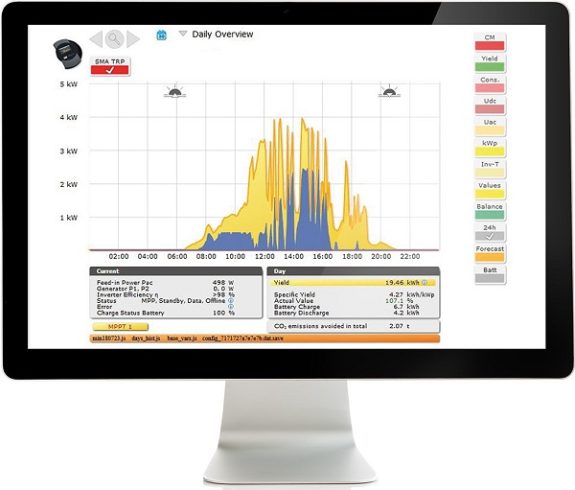Solare Datensysteme GmbH (SDS), manufacturer of the Solar-Log™ energy management system, has released a firmware update (Version 4.2.0) for the smart control of Varta battery systems.
Based on the weather forecast and consumption analysis, the Solar-Log™ energy management system determines the most effective charging times for the battery storage system. The battery charging is automatically controlled by the Solar-Log™ with the goal of preventing generated energy from being wasted and of having the battery 100% charged by the end of the day.
Binsdorf/Geislingen, Germany, 28 August 2018 – Unmanaged battery systems check the energy flow direction at the feed-in point and start charging the battery when power is being fed into the grid. In this case, the Solar-Log™ visualizes and documents the battery system’s charging processes.
The new forecast-based charging means that battery storage charging can now be intelligently controlled by the Solar-Log™ for more effective use of the PV plant’s power curve. This function is especially important for subsidized plants. To receive subsidies in Germany, only a certain percentage of power generated can be fed into the public power grid. This condition for the subsidies is intended to help create a grid-serving PV infrastructure aimed at maximum self-consumption.

Smart and Effective Charging
With forecast-based charging, each morning the Solar-Log™ determines the optimal times for charging throughout the day. This calculation is based upon the weather data, parameters of the PV plant and the battery system capacity.
Consumption Analysis for Smart Energy Management
In addition to the weather forecast data, the local consumption data is incorporated into the battery control management. The Solar-Log™ knows the typical past consumption data and checks if the calculated charging times are enough to charge the battery to capacity. The charging times are adjusted as needed.
Sunny Tuesday with High Self-Consumption
Here is an example for a Tuesday. Based on the past consumption data, there is a general indication that there is higher energy consumption in the afternoon. The weather forecast indicates that there will be moderate temperatures and strong solar irradiation for Tuesday. As a result, a maximum PV yield is expected. The 10 kWp PV plant can only feed 60% of the installed output into the grid in accordance with the regulations of the subsidy. In order to prevent the generated power from being wasted, it needs to be consumed locally.
The Solar-Log™ shifts the battery’s charging time to that when there is peak power production so that production does not have to be reduced. Since there is higher consumption in the afternoon, the Solar-Log™ adjusts the battery’s charging time frame. The goal is to have the battery 100% charged.
Solar-Log 300, 1200, 1900 and 2000 and the Varta Battery Storage Systems
The new smart battery charging is initially only available with the Varta battery storage systems and the Solar-Log 300,1200,1900 and Solar-Log 2000 models, as well as with the Solar-Log WEB Enerest™ online portal. Interface with other battery storage systems is already being planned.

































